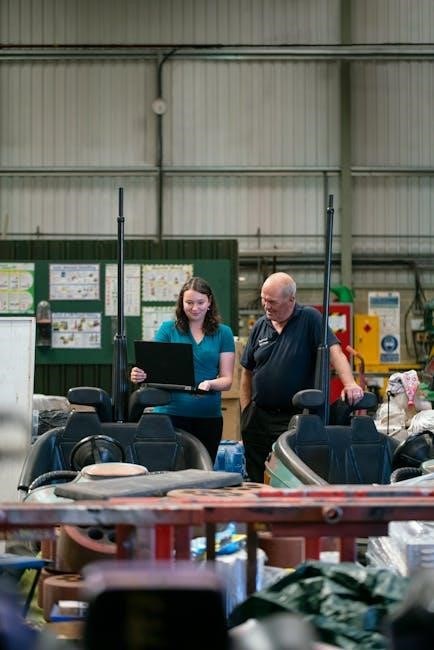Manual bottle filling machines are simple‚ efficient tools designed for filling bottles with liquids or pastes‚ ideal for small-scale production‚ DIY projects‚ and various industries.
Overview of Manual Bottle Filling Machines
Manual bottle filling machines are simple‚ cost-effective solutions for filling bottles with liquids or pastes. They are widely used in small-scale production‚ DIY projects‚ and various industries due to their ease of operation and portability. These machines typically rely on basic mechanisms like gravity‚ pistons‚ or peristaltic pumps to dispense precise amounts of liquid. They are ideal for users who need to fill a limited number of bottles without the complexity of automated systems. Their compact design and minimal maintenance make them a practical choice for startups and hobbyists.
Importance in Various Industries
Manual bottle filling machines play a crucial role across various industries‚ offering a cost-effective and reliable solution for filling bottles with precision. In the food and beverage sector‚ they enable small-scale production of liquids like juices‚ oils‚ and sauces. The pharmaceutical and cosmetic industries utilize them for filling medicinal or personal care products‚ ensuring hygiene and accuracy. Additionally‚ these machines are essential for DIY projects and small businesses‚ providing an affordable way to bottle products without the need for large-scale automation‚ making them versatile and indispensable tools.
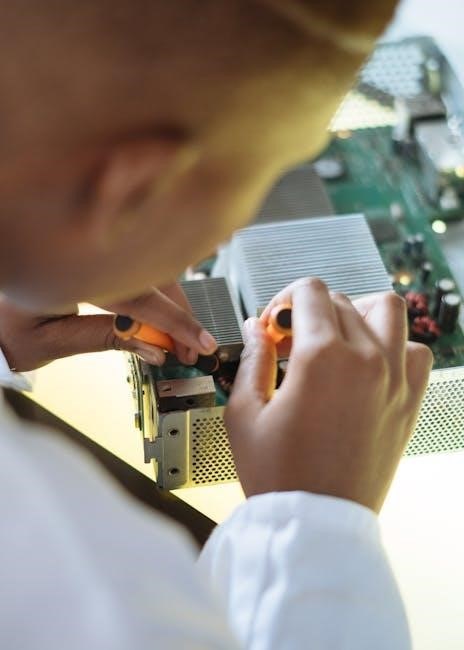
Types of Manual Bottle Filling Machines
Manual bottle filling machines include gravity-fed‚ piston-based‚ and peristaltic pump fillers‚ each offering unique benefits for various liquids‚ from thin beverages to thick pastes and gels.
Gravity-Fed Fillers
Gravity-fed fillers are simple‚ cost-effective machines that rely on gravity to dispense liquids from a reservoir into bottles. They are ideal for thin to medium-viscosity liquids like water‚ juice‚ and beer. These fillers are easy to operate‚ requiring minimal setup and maintenance. Their design ensures consistent filling levels‚ making them popular for small-scale production and DIY projects. With no complex mechanisms‚ they are durable and suitable for various industries‚ offering a reliable solution for manual bottle filling needs.
Piston-Based Fillers
Piston-based fillers use a piston mechanism to measure and dispense precise volumes of liquid into bottles. They are highly accurate and suitable for both thin and viscous liquids‚ such as sauces‚ creams‚ and oils. These fillers are commonly used in the food‚ beverage‚ and cosmetic industries. Their design allows for easy adjustment of fill levels‚ making them versatile for various bottle sizes. With minimal moving parts‚ piston-based fillers are durable and require less maintenance‚ ensuring efficient and reliable performance in manual bottle filling operations.
Peristaltic Pump Fillers
Peristaltic pump fillers utilize a flexible tube compressed by rollers‚ creating a pumping action to transfer liquids into bottles. This design eliminates direct contact between the liquid and machine components‚ reducing contamination risks. Ideal for sterile environments‚ these fillers are commonly used in pharmaceutical and cosmetic industries. They handle a wide range of viscosities and are easy to clean. The peristaltic pump’s gentle operation preserves the integrity of sensitive liquids‚ making it a popular choice for precise‚ contamination-free manual bottle filling applications in various sectors.

Working Principle of Manual Bottle Filling Machines
Manual bottle filling machines operate by allowing users to control the flow of liquid into bottles‚ often using a trigger or valve to start and stop filling.

Basic Components
A manual bottle filling machine typically consists of a filling chamber‚ an activation mechanism‚ a control valve‚ a nozzle‚ and a base or stand. The filling chamber holds the liquid to be dispensed‚ while the activation mechanism‚ such as a trigger or lever‚ controls the flow. The control valve regulates the liquid’s release‚ and the nozzle directs it into the bottle. Some models include measuring scales for precise filling. These components work together to ensure accurate and efficient bottle filling‚ making the machine versatile for various applications.
Step-by-Step Operation
Position the machine on a stable surface and prepare the bottles. Fill the machine’s reservoir with the desired liquid. Place a bottle under the nozzle‚ ensuring alignment. Activate the filling mechanism‚ such as pressing a lever or turning a handle‚ to start the flow. Monitor the fill level‚ stopping when the bottle is full. Remove the bottle and repeat for additional containers. Some models allow adjusting the fill volume for consistency. Proper operation ensures efficient and accurate bottle filling‚ making it ideal for various applications. Regular maintenance is recommended for optimal performance.

Advantages of Using Manual Bottle Filling Machines
Manual bottle filling machines offer cost-effectiveness‚ ease of use‚ and portability‚ making them ideal for small-scale operations. They require minimal setup and are efficient for various liquids.
Cost-Effectiveness
Manual bottle filling machines are budget-friendly solutions for small-scale operations. They require minimal investment compared to automatic machines‚ making them ideal for startups or DIY projects. With low maintenance and no high operational costs‚ these machines are economical for businesses needing flexibility without breaking the bank. Their affordability ensures a quick return on investment‚ especially for those with limited production needs. This cost-effectiveness makes manual fillers a practical choice for various industries and small businesses looking to save resources while maintaining efficiency.
Ease of Use
Manual bottle filling machines are designed for simplicity and ease of operation. They often feature intuitive controls and minimal moving parts‚ reducing the learning curve for users. With no complex programming or automation‚ these machines allow for quick setup and operation‚ making them accessible to individuals without specialized training. Their straightforward design ensures a smooth filling process‚ minimizing the risk of errors. This ease of use makes manual fillers ideal for small businesses‚ DIY enthusiasts‚ and anyone seeking a hassle-free bottling solution.
Portability
Manual bottle filling machines are typically lightweight and compact‚ making them highly portable. This portability allows users to easily move the machine between different locations‚ such as from a production area to a storage space or even to different facilities. Their compact design also saves storage space‚ which is particularly beneficial for small businesses or home-based operations. Additionally‚ the lack of complex infrastructure requirements means these machines can be set up and used virtually anywhere‚ providing flexibility and convenience for various bottling needs.

Applications of Manual Bottle Filling Machines
Manual bottle filling machines are widely used in the food and beverage industry‚ pharmaceutical and cosmetic sectors‚ and for DIY and small-scale production‚ offering versatile bottling solutions.
Food and Beverage Industry
Manual bottle filling machines are essential in the food and beverage industry for packaging liquids like water‚ juice‚ and oil. They offer precise control over fill levels‚ ensuring consistency and reducing waste. These machines are particularly popular among small-scale producers‚ craft breweries‚ and wineries‚ where flexibility and ease of use are crucial. Their compact design and portability make them ideal for limited production spaces‚ allowing businesses to efficiently bottle products while maintaining high standards of quality and hygiene.
Pharmaceutical and Cosmetic Industry
Manual bottle filling machines play a vital role in the pharmaceutical and cosmetic sectors‚ where precision and sterility are paramount. These machines are used for filling small batches of serums‚ ointments‚ and medications‚ ensuring accurate dosages and minimal contamination. Their ease of cleaning and adjustable settings make them suitable for handling sensitive products. Many models are designed with sanitary materials‚ making them compliant with industry regulations and ideal for laboratories and small-scale manufacturing facilities that require reliable‚ hygienic bottling solutions.
DIY and Small-Scale Production
Manual bottle filling machines are highly beneficial for DIY enthusiasts and small-scale producers‚ offering an affordable and portable solution for bottling liquids and pastes. These machines are easy to operate‚ allowing users to fill bottles with precision and minimal waste. They are ideal for crafting homemade products like sauces‚ cosmetics‚ and cleaning solutions. Their compact design and adjustable settings make them perfect for small batches‚ enabling creators to maintain quality control and customize their output efficiently.
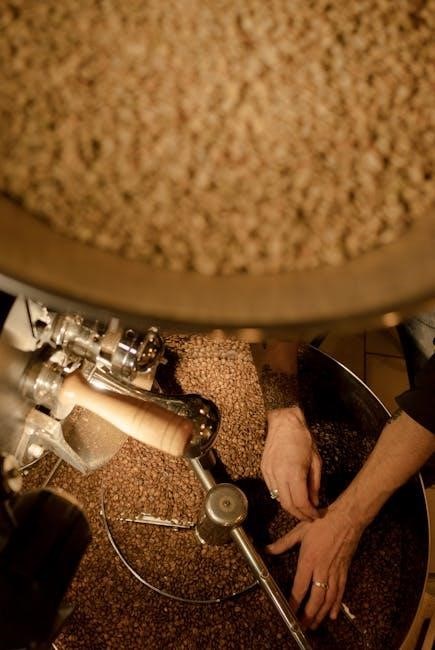
Factors to Consider When Buying a Manual Bottle Filling Machine
When selecting a manual bottle filling machine‚ consider compatibility with bottle sizes‚ material durability‚ and adjustability for precise filling. Ensure it suits your production needs and budget.
Bottle Size and Shape Compatibility
Bottle size and shape compatibility are crucial factors to ensure efficient filling. Manual machines must accommodate various bottle dimensions‚ from small glass bottles to larger containers. Adjustable shelves or fillers can handle different bottle shapes‚ ensuring proper alignment and filling accuracy. Compatibility ensures that the machine works seamlessly with your specific bottle needs‚ preventing spills and ensuring consistent results.
Material and Build Quality
Material and build quality are essential for durability and performance. Stainless steel and food-grade HDPE are common‚ ensuring safety and resistance to corrosion. Machines with sturdy frames and high-quality components last longer and maintain accuracy. Look for models with seamless construction to prevent contamination. Durable materials also simplify cleaning and maintenance‚ ensuring longevity. A well-built machine guarantees reliable operation and meets food safety standards‚ making it a worthwhile investment for consistent bottle filling needs.
Adjustability and Precision
Adjustability and precision are crucial for consistent filling results. Look for machines with fill-level controls and interchangeable components to accommodate different bottle sizes and shapes. Adjustable mechanisms ensure accurate filling volumes‚ reducing waste and overflow. Precision engineering guarantees repeatable results‚ maintaining consistency across batches. Machines with adjustable settings are versatile‚ catering to various liquids and viscosities. This adaptability makes them ideal for small businesses and DIY projects‚ ensuring high-quality output with minimal effort. Easy-to-use controls enhance precision‚ allowing operators to fine-tune settings for optimal performance.
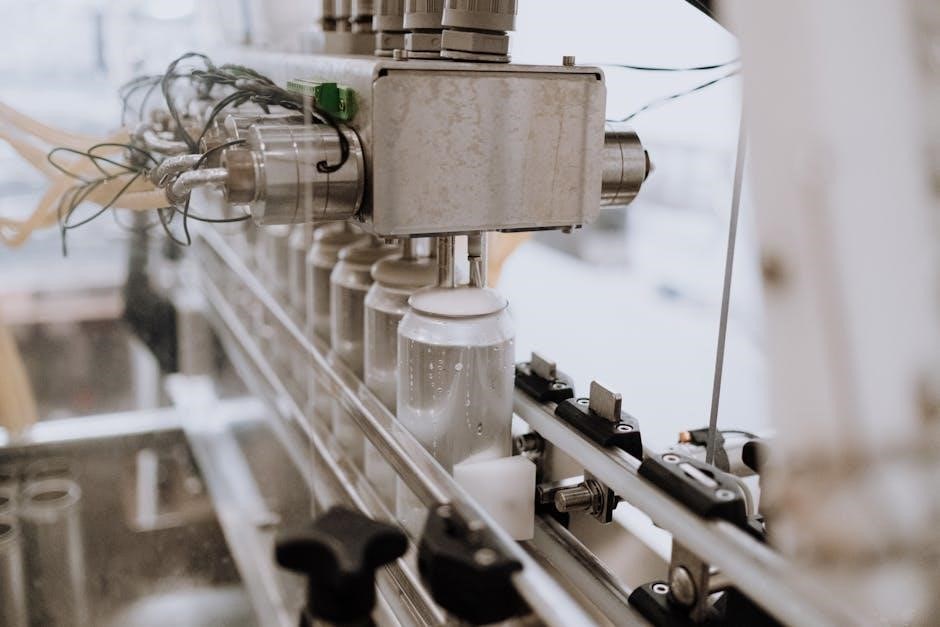
Maintenance and Care Tips
Regular cleaning and sanitizing are essential to prevent contamination and ensure optimal performance. Lubricate moving parts periodically to maintain smooth operation and extend machine lifespan. Store the machine in a dry‚ clean environment when not in use‚ and check for wear and tear. Always refer to the user manual for specific maintenance instructions to keep your manual bottle filling machine in excellent condition.
Cleaning and Sanitizing
Regular cleaning and sanitizing are crucial for maintaining hygiene and preventing contamination. Use mild detergents and warm water to clean all surfaces‚ paying attention to nozzles and seals. Rinse thoroughly to remove any residue. Sanitize the machine with a food-grade sanitizer or alcohol solution‚ ensuring all parts are disinfected. Allow the machine to air dry to prevent moisture buildup‚ which can lead to bacterial growth. Always follow the manufacturer’s guidelines for cleaning and sanitizing to ensure optimal performance and longevity of your manual bottle filling machine.
Regular Lubrication
Regular lubrication is essential to ensure smooth operation and prevent wear on moving parts. Apply food-grade lubricant to gears‚ hinges‚ and seals as needed‚ especially after cleaning. This maintains efficiency and longevity. Always refer to the manual for specific lubrication points and recommended products. Proper lubrication prevents friction damage and ensures precise filling accuracy. Lubricate after sanitizing and before storage to protect against corrosion; Regular maintenance extends the machine’s lifespan and ensures reliable performance in various production environments. Consistency in lubrication routines is key to optimal functionality.
Storage and Handling
Proper storage and handling of manual bottle filling machines are crucial to maintain their performance and longevity. Always clean and dry the machine thoroughly before storing it in a secure‚ dry location. Avoid exposing the machine to extreme temperatures or direct sunlight‚ as this can damage components. When handling‚ ensure the machine is placed on a stable surface to prevent accidental damage. Use protective covers if storing for extended periods. Handle moving parts with care to avoid misalignment or breakage. Proper storage ensures the machine remains in optimal condition for future use.
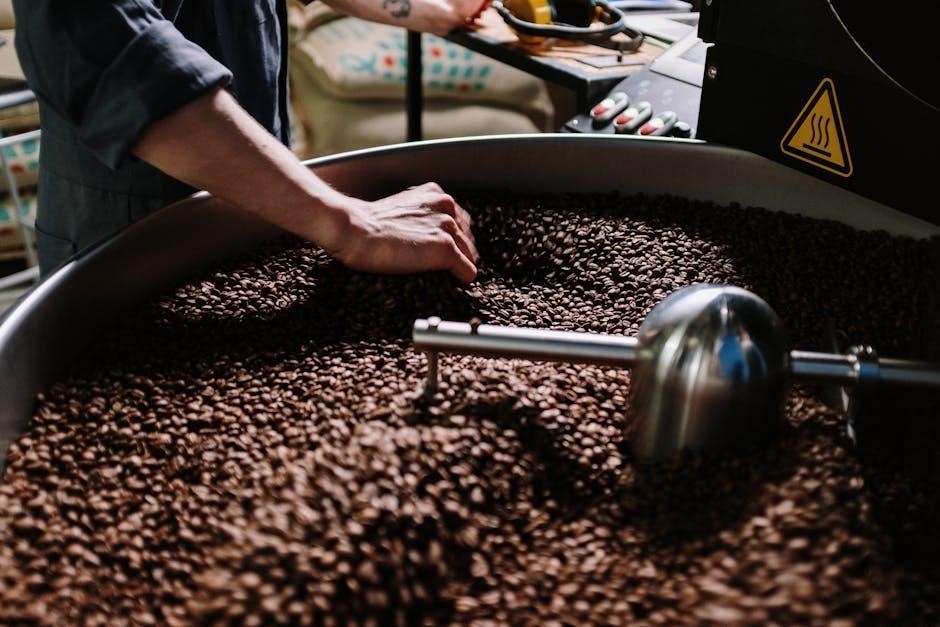
Troubleshooting Common Issues
Identify and resolve issues promptly by checking the manual‚ ensuring cleanliness‚ and verifying proper alignment of components. Test with a small batch to confirm functionality and accuracy.
Low Filling Accuracy
Low filling accuracy can occur due to improper calibration‚ worn-out seals‚ or misaligned nozzles. Check for consistent liquid levels and ensure the machine is clean. Adjust the filling height and flow rate as needed. Verify bottle size compatibility and inspect for blockages. Regular maintenance‚ such as replacing worn parts and lubricating moving components‚ can improve precision. Consult the manual for specific calibration instructions or contact a professional if issues persist. Proper setup and regular upkeep are key to achieving accurate fills consistently.
Machine Jamming
Machine jamming can occur due to blockages‚ misaligned bottles‚ or excessive liquid viscosity. Turn off the machine immediately and inspect for obstructions in the filling nozzles or valves. Clean the machine thoroughly and ensure all parts are properly aligned. Check the bottle size compatibility and avoid overfilling. Regular lubrication of moving parts and maintaining a clean workspace can prevent jams. If the issue persists‚ refer to the manual or contact a technician for professional assistance. Proper maintenance and operation are essential to minimize downtime and ensure smooth functionality.
Leakage Problems
Leakage issues in manual bottle filling machines often arise from loose connections‚ worn-out seals‚ or improper alignment. Check all joints and tighten any loose parts. Inspect the gaskets and seals for wear and tear‚ replacing them if necessary. Ensure the machine is clean‚ as residue can cause leaks. Regularly lubricate moving parts to maintain smooth operation. Using the correct bottle size and type can also prevent leakage. Addressing these issues promptly helps maintain efficiency and reduces product waste‚ ensuring reliable performance over time.

Future Trends in Manual Bottle Filling Technology
Manual bottle filling machines are evolving with automation integration‚ sustainable materials‚ and smart features‚ enhancing efficiency‚ precision‚ and user connectivity for future operations.
Integration with Automation
Manual bottle filling machines are increasingly integrating automation‚ offering enhanced efficiency and precision. This blend of manual control with automated features allows for scalable production‚ reduced errors‚ and improved consistency. Modern systems incorporate sensors and IoT connectivity‚ enabling real-time monitoring and adjustments. Automation also streamlines processes like bottle detection and filling volume control‚ minimizing downtime. These advancements make manual machines more versatile‚ catering to both small-scale and growing operations while maintaining ease of use and affordability.
Sustainable Materials
Manual bottle filling machines are now being crafted with sustainable materials‚ reducing environmental impact. Eco-friendly options like stainless steel and food-grade plastics ensure durability and recyclability. These materials minimize waste and align with green production practices. Sustainable designs also focus on energy efficiency‚ lowering carbon footprints. By using responsibly sourced components‚ manufacturers promote environmental stewardship while maintaining performance and safety standards. This shift supports businesses aiming to adopt eco-conscious practices without compromising on quality or functionality.
Smart Features and Connectivity
Modern manual bottle filling machines now incorporate smart features and connectivity to enhance efficiency. Advanced models offer digital controls‚ app connectivity‚ and automation capabilities. These innovations enable precise filling‚ real-time monitoring‚ and data tracking. Some machines integrate with smartphones or tablets‚ allowing users to adjust settings remotely. Features like FillSafe recognition automatically detect bottle size and optimize filling. These intelligent advancements streamline operations‚ reduce errors‚ and improve productivity‚ making manual fillers more versatile and adaptable to evolving production needs while maintaining their simplicity and cost-effectiveness.
